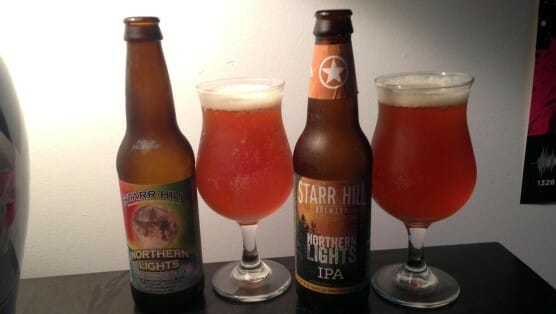Starr Hill Northern Lights IPA — New Recipe

It’s an interesting process to watch consumer tastes change in real time in the world of craft beer. With 3,000-plus breweries now in operation in the U.S.A., and a constant stream of new seasonal releases and innovation, the definitions of popular styles such as IPA have come a long way in a comparably short time.
Although perhaps “definitions” isn’t the right word. What’s really changed, particularly in IPA, is which kinds of flavor profiles are now sought-after. Compare historical ratings on beer sites such as BeerAdvocate and Ratebeer, and you can see the change unfold over the last five or so years. We still love IPA with just as much fervor, but beer geeks are now seeking a different kind of IPA. The gushed-about India pale ales of 2015 bear little resemblance to the ones that were hailed as top of the class in 2010.
Those classical, now apparently antiquated IPAs, tended to fit into a specific sort of mold: Bitter, dry, citrus and piney, a bit of balancing crystal malt. Perhaps they had a different hop twist—floral or herbal?—but more or less, these were the IPAs you’d be hearing about. Take an IPA like say … Ballast Point Sculpin. Or Bell’s Two Hearted. Or Bear Republic Racer 5. Nobody is saying those beers are now lesser examples of the style, but they’re not reflective of what has become popular in the current wave.
The modern IPA has transformed into a much more sumptuous sort of experience. Pure bitterness has been dialed back a touch in favor of larger, later additions of hops that impart more aroma and flavor without added bitterness. New hop varietals such as Citra, Mosaic and southern hemisphere styles like Galaxy and Nelson Sauvin have become the go-to, buzzed-about flavor profiles. They largely share one thing in common: Intense, juicy tropical fruit flavors—or in the case of the Nelson, a certain citrusy, white wineyness. The malt bills have changed a bit as well, typically cutting back a bit on the crystal/caramel malt in favor of letting those enhanced aromatics shine. The modern IPA is light of color and body but exploding with easy to drink fruit flavors. Think of say, Three Floyds Zombie Dust, which is an IPA masquerading as an APA, as a perfect example.
And so, when I started to read a press release from Starr Hill explaining that they had redesigned the recipe of their Northern Lights IPA, I already knew what it would say in advance. Breweries are, after all, businesses first and foremost. I can’t say if the owners at Starr Hill actually wanted to change the profile of their IPA, but they clearly made a decision that this was the way the market and their consumer base was trending. The IPA they first put out in 2007 was no longer representative of their demographic.
That, and the brewery has already seen the positive effects of modernization. Their new King of Hop DIPA is excellent (although oddly low-ABV) stuff, and we fittingly gave it a glowing review back in April. With it, they’d proved they could make a very good IPA. So why not reapply those principals to their flagship?